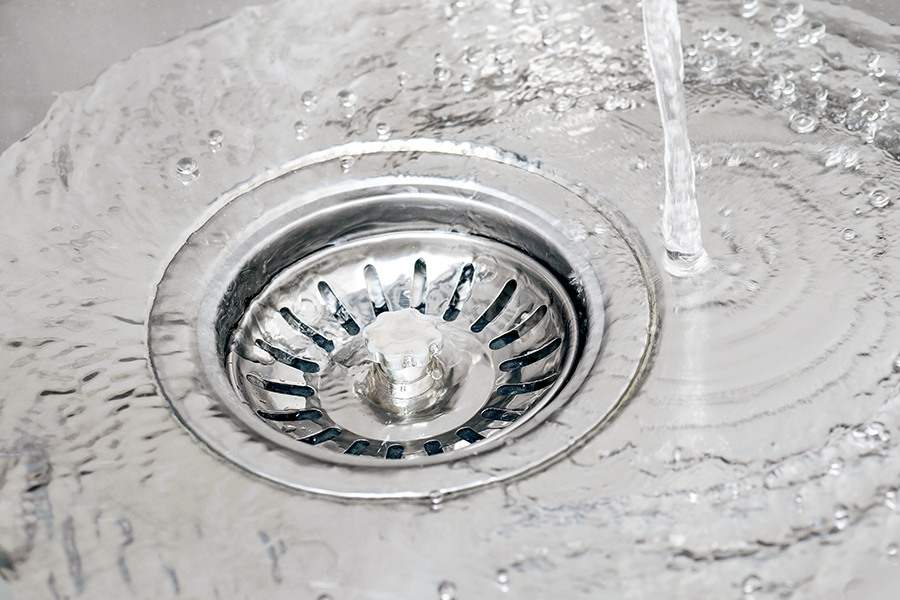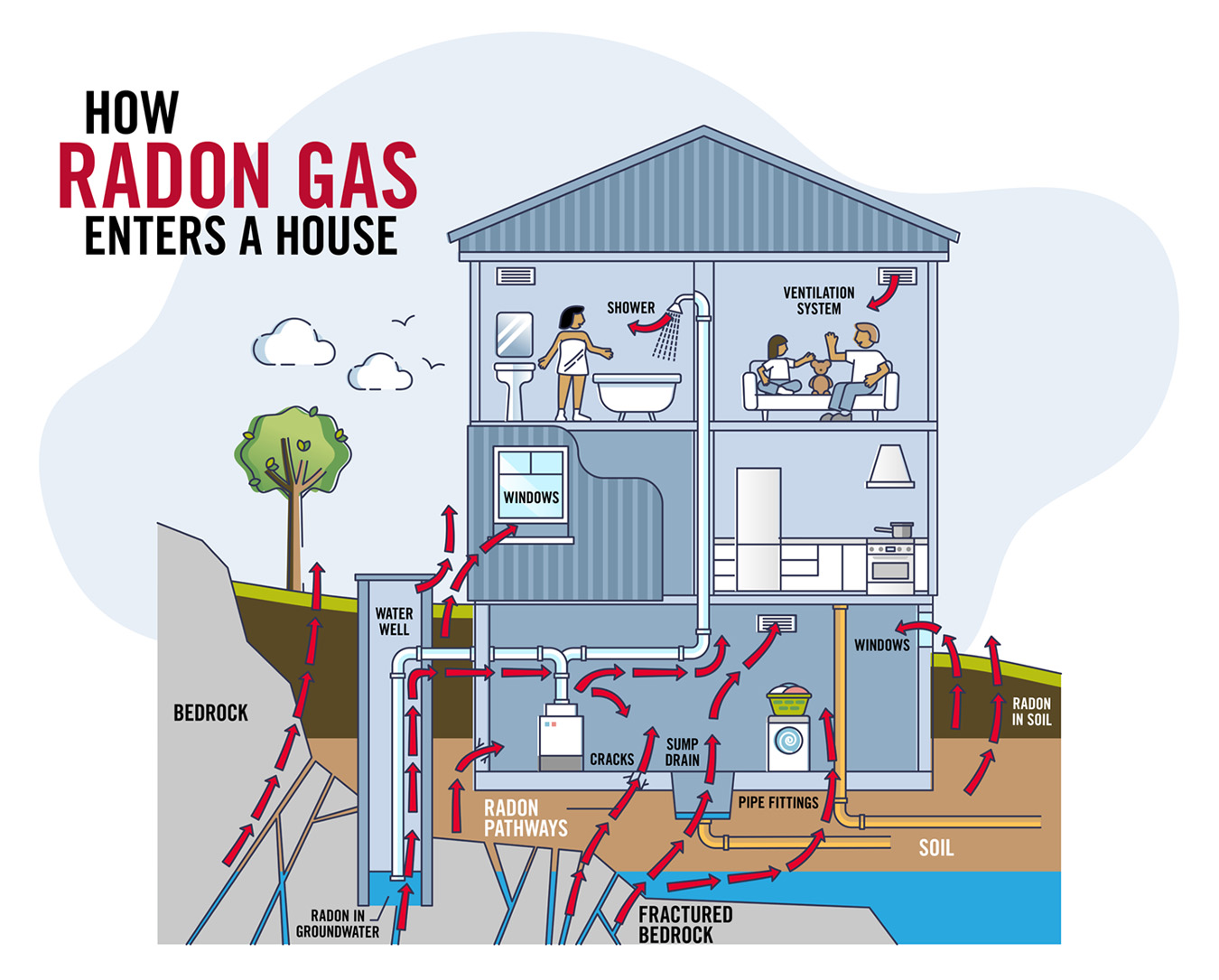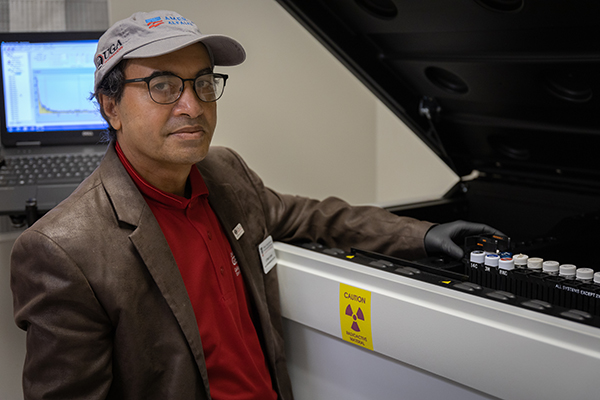About Microfiltration
Microfiltration is one of the multiple types of pressure-driven membrane separation processes—among them microfiltration, ultrafiltration, nanofiltration, and reverse osmosis—which are used for the physical removal of several contaminants from water. This publication focuses primarily on the microfiltration process, which uses a simple permeable membrane and removes contaminants such as suspended solids and certain microorganisms.
These filters are suitable for cleaning water lightly loaded with suspended materials, but not for waters with heavy loads of them. When water has heavy loads of suspended materials, a sediment prefilter is recommended. Refer to UGA Extension Bulletin 1523, Mechanical Filtration Methods and Devices (https://extension.uga.edu/publications/detail.html?number=B1523) for various types of sediment filters.
The extent to which suspended solids and microorganisms are removed by microfiltration is determined by the filter’s pore size or openings in the membrane (discussed in the “Types of Filters” section). Substances that are larger than the pores in the membranes are removed. Microfiltration membranes have a larger pore size than found in ultrafiltration, nanofiltration, and reverse osmosis systems, so they remove fewer suspended solids and other substances from water.
Microfiltration is effective against small particles and suspended solids such as ferric iron, clay, silt, and sand, some pathogens—such as bacteria and protozoan parasites (e.g., Giardia and Cryptosporidium), and some colloids (smaller sized suspended matter).
Microfiltration is not effective against any dissolved contaminants such as nitrates, dissolved iron, sodium, volatile organic compounds (VOCs), and viruses.
How Microfiltration Works
Microfilters physically separate suspended materials through two general types of filters:
- Surface or screen filters remove the particles at or very near the filter surface. They function very much like a screen; particles of a certain size and larger are retained at the surface while smaller ones move through the openings.
- Depth filters have a thick filter medium. Particles are retained throughout the thick filter mat. Depth filters have a gradation in the pore size of the filter media, so the largest particles are held at or near the filter surface, while progressively smaller particles are captured deeper in the filter, where the pore size of the filter media becomes smaller.
Both surface and depth filters may be used for a wide range of particle sizes.
Types of Filters
Microfiltration filter options differ in design, pore size, cost, and effectiveness. The pore size is the diameter of the tiny holes or openings in a filter that allow water to pass through. The pore size of microfilter membranes varies from 0.1 to 10 microns. A micron is equal to one-millionth (10-6) of a meter, which is approximately 0.00004 in.
Microfilters are rated based on pore size or the filter openings (Figure 1), according to either:
- the mean (average) pore size of the filter: This rating is used when the filter construction results in a range of pore sizes. Filters with an average pore size rating should be selected when the separation and removal of solids that have a range of particle sizes is important, such as when reducing turbidity (cloudiness).
- the absolute pore size of the filter: This rating method is used when the filter construction results in precise openings or pore sizes over a narrow range. Filters with an absolute size rating should be selected when the separation and removal of specific-size particles is important, such as when bacteria need to be removed.
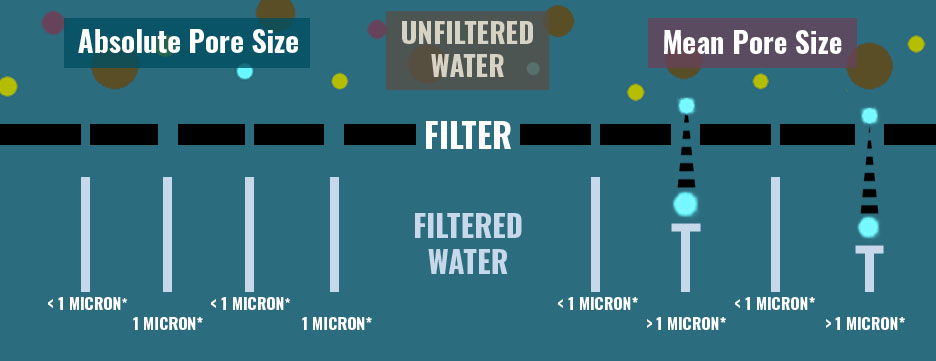
The filter opening or pore size to use depends upon the material to be removed by the filter (see Figure 2).

Figure 3 summarizes the types of particles that are removed from the water with each type of membrane filter. The green arrows indicate the particles are small enough to pass through the filter, while the deflected red lines indicate that the filter blocks the particles from passing through the filter—in other words, they are removed from the water.
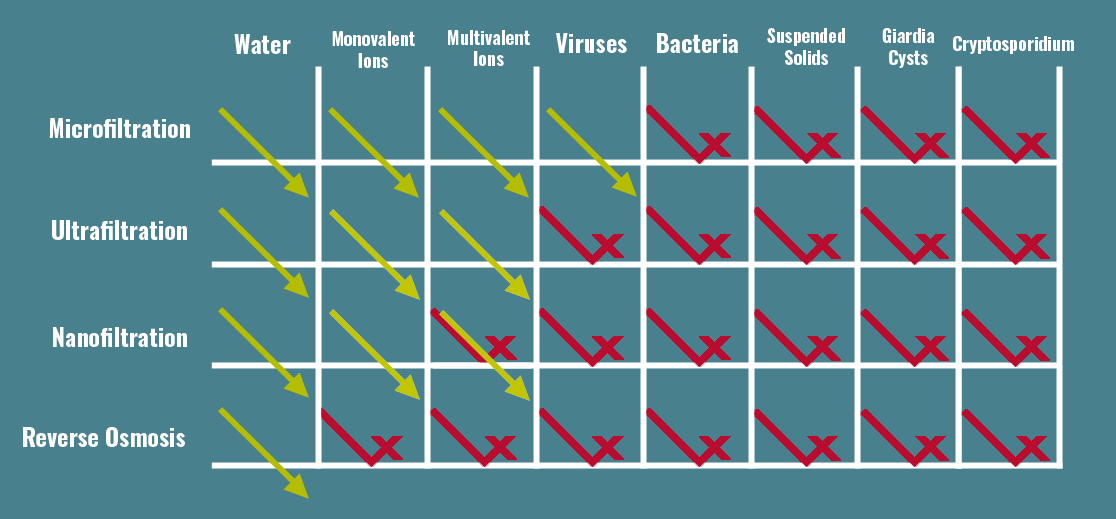
A microfilter membrane with a smaller pore size will be more effective in removing contaminants, but it will also require more frequent cleaning or replacement. If very small solid particles or bacteria are not a concern, a larger rating size will serve your purposes and will require less maintenance. Microfiltration is normally part of the household plumbing system (whole house or point-of-entry). If microfiltration is part of another water treatment system, such as a reverse osmosis unit, then it is generally installed as a point-of-use or under-sink system.
Maintenance
Even if you buy a costly and high-quality water treatment device, it will not perform properly unless it is installed and managed according to the manufacturer’s recommendations, including operation, cleaning, and part replacement. Keep a logbook to record equipment maintenance and repairs.
Some microfiltration units are nearly self-monitoring. When the filter becomes clogged, the pressure drops across the filter, and water flow decreases. This indicates that the filter needs service. As long as the filter remains in place and there are no leaks through the filter or the seals, the process works safely with little attention.
Other Considerations
Testing
- Before purchasing a water treatment device, have your water tested to determine the contaminants present.
- The UGA Agricultural and Environmental Services Laboratories and other accredited laboratories provide comprehensive water testing for a fee.
Assess Your Filtration Needs
- Confirm that microfiltration is the appropriate treatment method for your system and that it will remove the contaminant(s) you anticipate removing from your water.
- Consider the size of the filter you need, which should be based on the contaminant(s) that need to be removed.
- Determine whether the treatment system has been tested and certified by the National Sanitation Foundation (NSF; https://www.nsf.org) or Water Quality Association (WQA; https://wqa.org) to ensure that it meets the manufacturer’s claims.
Installation and Operation
- Determine any special installation requirements that may add to the equipment cost. For example, if you need to make changes to your household plumbing.
- After installation, retest both the raw water (prior to treatment) and the treated water to ensure that the system is working and removing the contaminants properly.
- You should continue to test the quality of both the untreated and treated water semiannually or annually. This testing will help you determine how well your treatment system is working and whether maintenance or replacement of components may be necessary.
- Bacteria can grow on the filter and impede water flow, so it is important that you change the filter as necessary to ensure your system continues to provide adequate throughput.
References
Bagley, D. (2017, April 11). A guide to home water treatment (Bulletin E3342). Michigan State University Extension. https://www.canr.msu.edu/resources/a_guide_to_home_water_treatment_bulletin_e3342
Centers for Disease Control and Prevention. (2024a, April 10). About choosing home water filters. https://www.cdc.gov/drinking-water/prevention/about-choosing-home-water-filters.html
Centers for Disease Control and Prevention. (2024b, April 10). About home water treatment systems. https://www.cdc.gov/drinking-water/about/about-home-water-treatment-systems.html
Daniels, B., & Mesner, N. (2010). Drinking water fact sheet: Drinking water treatment systems (Publication No. 508). Utah State University Cooperative Extension. https://digitalcommons.usu.edu/extension_curall/508/
Dvorak, B. I., & Skipton, S. O. (2014). Drinking water treatment: An overview (Publication No. EC703). University of Nebraska-Lincoln Extension. https://extensionpubs.unl.edu/publication/ec703/pdf/view/ec703-2014.pdf
Eubank, W., Carpenter, J. D., Maltsberger, B. A., & Anderson, N. (Eds). (2017). Understanding your home water treatment systems. University of Missouri Extension. https://extension.missouri.edu/publications/eq104
Private Well Program. (2009, April). Micro filtration treatment of private drinking water systems (Publication No. 14). The State of Connecticut Department of Public Health, Environmental Health Section. https://portal.ct.gov/-/media/Departments-and-Agencies/DPH/dph/environmental_health/pdf/14MicroFiltrationTreatmentofPDWWpdf.pdf
University of Rhode Island Department of Health & University of Rhode Island Cooperative Extension. (2022). Safe well water RI: Microfiltration water treatment systems (Tip Sheet No. 22). https://web.uri.edu/wp-content/uploads/sites/61/TipSheetT22_Microfiltration.pdf
Wagenet, L., Mancl, K., & Sailus, M. (1995). Home water treatment (Publication No. NRAES-48). Cornell Cooperative Extension. https://hdl.handle.net/1813/67139
Water Systems Council. (n.d.). wellcare® information for you about water treatment. https://www.watersystemscouncil.org/download/wellcare_information_sheets/well_water_testing_&_treatment_information_sheets/Water-Treatment.pdf






